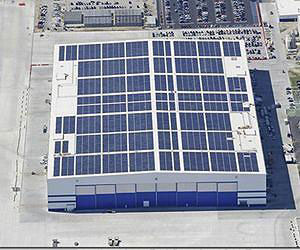While much of the US has embraced efficiency and renewable energy, the southeast has resisted it, but that could finally be changing.
In South Carolina, utility SCE&G plans to build five solar farms across the state that add up to 20 megawatts (MW), a small step forward from the pathetic 4 MW installed state-wide.
Half of the solar currently installed is on one roof – 2.6 MW covering the Boeing factory that assembles the 787 Dreamliner airplane. Back in 2011, it was one of the larger rooftop projects in the US:

"We now have three of the major energy providers in South Carolina recognizing the benefits of solar energy, which is a huge shift from just five years ago,” Andrew Streit, a former board member of the South Carolina Solar Council, told The State.
In a series of stories last year, the newspaper outlined how restrictive state laws, a lack of tax incentives or any encouragement, and opposition from utilities have made South Carolina one of the least friendly states for solar, despite having lots of sunshine and interested residents. Other newspapers also have begun reporting on the issue, bringing it into the spotlight.
"I’d say the tide has turned and they are more receptive,” Grant Reeves, president of the South Carolina Solar Business Alliance, told The State. "The proof will be how they advocate with the General Assembly in January. If they quit blocking things and become more cooperative, it will be a good day in South Carolina. I’m optimistic.”
After many months of crafting a bill that included the solar industry, supportive policy passed almost unanimously out of committee, but it gives local utilities including powerful Duke Energy a monopoly over installations, says the solar industry.
North Carolina has broken through in the South, so much so that even ALEC couldn’t get the Renewable Portfolio Standard (RPS)repealed. West Virginia is the only other state with a RPS – Virginia’s is voluntary. Alabama, Mississippi and Tennessee have no supportive policies – no RPS, no net metering, or even interconnection standards, says ACORE in a report on the region. Georgia recently made moves on solar.
If you wonder why there isn’t more solar in Florida, it’s because "utilities exert power over state politics at a level surpassed only by their monopoly control over electricity itself," concludes "Power Play: Political influence of Florida’s top energy corporations."
Produced by Integrity Florida, it accuses Florida Power & Light, Duke Energy, TECO, and Gulf Power of deploying hundreds of lobbyists ($12 million from 2007-2013) and millions of dollars ($18 million in 2004-2012 elections) to influence state political and regulatory bodies to protect monopoly utility interests. Their goal is to suppress growing public demand for rooftop solar, consumer choice and market competition.
Florida doesn’t have a RPS and doesn’t allow power purchase agreements.
What About Wind Energy?
The same situation is true for wind energy – the Southeast lags the rest of the country. One reason is that much of the region doesn’t have high winds, but the bigger problem goes back to a general hostility toward renewable energy (coal country), spurred by the likes of ALEC. There’s no installed wind capacity there at all.
Although a few states are accessing wind energy by signing power purchase with out-of-state developers, there’s a general lack of "market signals attractive to renewable energy developers and investors – including appropriate incentives and government initiatives," says ACORE.
Last month, the US Department of Energy (DOE), announced it is setting Wind Energy Resource Centers in every region of the country, including the southeast.
And Energy Efficiency?
And yes, the same is true for energy efficiency – no incentives or positive signals.
Indeed, the South is so inefficient that retrofits in 16 cities resulted in a 387% return on investment, says the Southeast Energy Efficiency Alliance.
Seeded with $20.2 million from the DOE, they led a program which audited 10,000 buildings, resulting in 6000 residential and commercial retrofits.
According to an analysis of the program, it produced wide-ranging benefits, creating hundreds of jobs and $78.3 million in economic output.
Read ACORE’s report:

